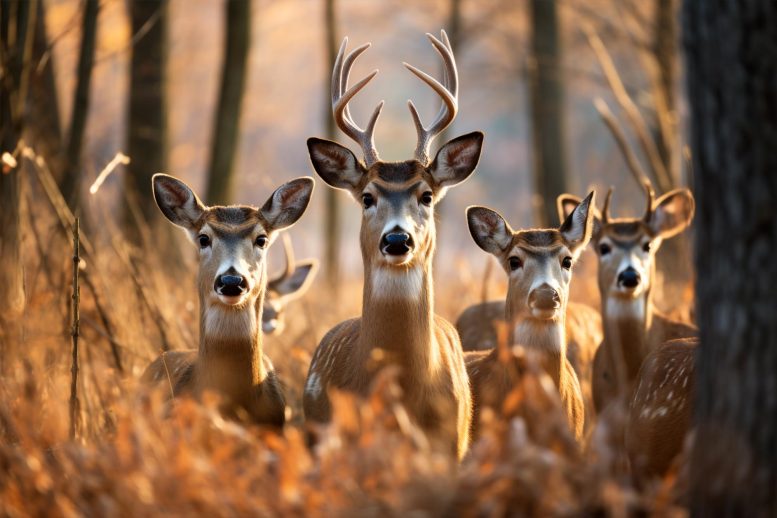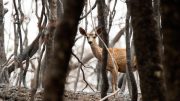
Research reveals that Ohio’s white-tailed deer carry the COVID-19 virus, with the virus variants evolving three times faster in deer than in humans. The implications for potential cross-species transmission in the future remain unclear.
Study finds deer are virus reservoirs, promoting ongoing mutation.
New research has found that white-tailed deer across Ohio have been infected with the virus that causes COVID-19. Alarmingly, the results also show that viral variants evolve about three times faster in deer than in humans.
Scientists collected 1,522 nasal swabs from free-ranging deer in 83 of the state’s 88 counties between November 2021 and March 2022. More than 10% of the samples were positive for the SARS-CoV-2 virus, and at least one positive case was found in 59% of the counties in which testing took place.
Genomic Analysis and Findings
Genomic analysis showed that at least 30 infections in deer had been introduced by humans – a figure that surprised the research team.
“We generally talk about interspecies transmission as a rare event, but this wasn’t a huge sampling, and we’re able to document 30 spillovers. It seems to be moving between people and animals quite easily,” said Andrew Bowman, associate professor of veterinary preventive medicine at The Ohio State University and co-senior author of the study.
“And the evidence is growing that humans can get it from deer – which isn’t radically surprising. It’s probably not a one-way pipeline.”
The combined findings suggest that the white-tailed deer species is a reservoir for SARS-CoV-2 that enables continuing mutation, and that the virus’s circulation in deer could lead to its spread to other wildlife and livestock.
The study is published today (August 28, 2023) in the journal Nature Communications.
Previous Observations and Expansions
Bowman and colleagues previously reported detection of SARS-CoV-2 infections in white-tailed deer in nine Ohio locations in December 2021, and are continuing to monitor deer for infection by more recent variants.
“We expanded across Ohio to see if this was a localized problem – and we find it in lots of places, so it’s not just a localized event,” Bowman said. “Some of the thought back then was that maybe it’s just in urban deer because they’re in closer contact with people. But in rural parts of the state, we’re finding plenty of positive deer.”
Beyond the detection of active infections, researchers also found through blood samples containing antibodies – indicating previous exposure to the virus – that an estimated 23.5% of deer in Ohio had been infected at one time or another.
Variant Analysis
The 80 whole-genome sequences obtained from the collected samples represented groups of various viral variants: the highly contagious delta variant, the predominant human strain in the United States in the early fall of 2021 that accounted for almost 90% of the sequences, and alpha, the first named variant of concern that had circulated in humans in the spring of 2021.
The analysis revealed that the genetic composition of delta variants in deer matched dominant lineages found in humans at the time, pointing to the spillover events, and that deer-to-deer transmission followed in clusters, some spanning multiple counties.
“There’s probably a timing component to what we found – we were near the end of a delta peak in humans, and then we see a lot of delta in deer,” Bowman said. “But we were well past the last alpha detection in humans. So the idea that deer are holding onto lineages that have since gone extinct in humans is something we were worried about.”
The study did suggest that COVID-19 vaccination is likely to help protect people against severe disease in the event of a spillover back to humans. An analysis of the effects of deer variants on Siberian hamsters, an animal model for SARS-CoV-2 studies, showed that vaccinated hamsters did not get as sick from infection as unvaccinated animals.
Rapid Evolution in Deer
Disturbingly, the variants circulating in deer are expected to continue to change. An investigation of the mutations found in the samples provided evidence of more rapid evolution of both alpha and delta variants in deer compared to humans.
“Not only are deer getting infected with and maintaining SARS-CoV-2, but the rate of change is accelerated in deer – potentially away from what has infected humans,” Bowman said.
How the virus is transmitted from humans to white-tailed deer remains a mystery. And so far, even with about 30 million free-ranging deer in the U.S., no substantial outbreaks of deer-origin strains have occurred in humans.
Potential Implications
Circulation among animals, however, remains highly likely. Bowman noted that about 70% of free-ranging deer in Ohio have not been infected or exposed to the virus, “so that’s a large body of naive animals that the virus could spread through rather uninhibited.”
“Having that animal host in play creates things we need to watch out for,” he said. “If this trajectory continues for years and we have a virus that becomes deer-adapted, then does that become the pathway into other animal hosts, wildlife or domestic? We just don’t know.”
Reference: “Accelerated evolution of SARS-CoV-2 in free-ranging white-tailed deer” by Dillon S. McBride, Sofya K. Garushyants, John Franks, Andrew F. Magee, Steven H. Overend, Devra Huey, Amanda M. Williams, Seth A. Faith, Ahmed Kandeil, Sanja Trifkovic, Lance Miller, Trushar Jeevan, Anami Patel, Jacqueline M. Nolting, Michael J. Tonkovich, J. Tyler Genders, Andrew J. Montoney, Kevin Kasnyik, Timothy J. Linder, Sarah N. Bevins, Julianna B. Lenoch, Jeffrey C. Chandler, Thomas J. DeLiberto, Eugene V. Koonin, Marc A. Suchard, Philippe Lemey, Richard J. Webby, Martha I. Nelson and Andrew S. Bowman, 28 August 2023, Nature Communications.
DOI: 10.1038/s41467-023-40706-y
Martha Nelson of the National Library of Medicine was co-corresponding author of the study. Ohio State co-authors Dillon McBride, Steven Overend, Devra Huey, Amanda Williams, Seth Faith and Jacqueline Nolting worked on the study with co-authors from St. Jude Children’s Research Hospital; the University of California, Los Angeles; the National Research Centre in Giza, Egypt; PathAI Diagnostics; the Ohio Department of Natural Resources; the U.S. Department of Agriculture; Columbus and Franklin County Metroparks; and the Rega Institute for Medical Research in Belgium.
This work was supported by the National Institute of Allergy and Infectious Diseases and Ohio State’s Infectious Diseases Institute.






They wouldn’t know all that at this point …unless they did it?
Here goes the conspiracy theory from the crazy white guy
Another way for the government to control the ppl more and Lilley a bunch of lies just like the Dems every time they open there mouth .More BS…
What a tacky AI generated photo to use. Those are not WTD.
Without any other plausible mechanism proposed for spreading COVID from humans to deer, I think the one obvious culprit should be openly discussed. Clearly, men have been slipping away from their wives to go deer “hunting”. This makes sense. It used to be more acceptable for men to go outside and “check on the sheep”. However, after the rise of industrialization and the concentration of sheep husbandry into centralized locations, men invented the deer “hunting” excuse.